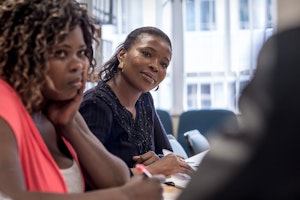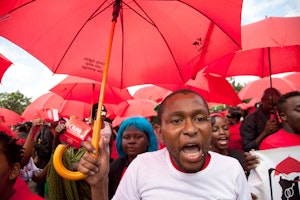We Do Exist: Gay Men and HIV Risk in Kazakhstan
By Heather Doyle
There is general consensus among scientists and public health professionals that ending AIDS requires full participation from the most-at-risk populations, including men who have sex with men (MSM). Yet, many countries still do not collect data on HIV infections in MSM populations. In low- and middle-income countries, MSM are 19 times more likely to be infected with HIV than the general population. Experts estimate, however, that only nine percent of MSM globally are reached with HIV prevention services. Policymakers continue to ignore the needs of MSM because this population has traditionally been understudied and underfunded.
When researchers met with the Republican AIDS Center in Kazakhstan in 2009, the government body responsible for the national response to HIV, to ask why MSM were left out of the AIDS response, they were told that gay men did not exist in Kazakhstan. Of course common sense suggests otherwise, but it took a scientific study to confirm the reality. A recent study by the Johns Hopkins Center for Public Health and Human Rights, the Global Health Research Center of Central Asia at Columbia University (GHRCCA), and the local organization Amulet, documents that MSM in Kazakhstan not only exist, but they are at elevated risk of HIV. According to the study, nearly 90 percent of the men interviewed had trouble accessing free condoms, only 33 percent had ever had an HIV test, and more than 60 percent were afraid to tell their health care providers about their sexual orientation. Researchers found an HIV prevalence rate among MSM of 20 percent, compared to a rate of .1 percent among the general population of adults aged 15-49.
This data has provided an opportunity for researchers, activists, and government officials to better understand the epidemic and the most appropriate national response. The project has already resulted in some important advances in the national discussion and funding priorities. The study team from Johns Hopkins School of Public Health—Mark Berry, Chris Beyrer, and Andrea Wirtz—discuss below why this study is so important and how it may improve the national response to HIV in Kazakhstan.
What was the original motivation to carry out this study and focus on MSM?
Our previous research from around the world has consistently demonstrated that MSM tend to be underserved, understudied, and have much higher risk of HIV acquisition than the heterosexual population. MSM are at greater risk to due biologic factors as well as lack of targeted prevention programs and lack of awareness of this risk. We use the term MSM in recognition that not all men who have sex with men identify as homosexual. As a result, reaching these populations and providing essential information to prevent HIV infection takes special efforts and requires additional sensitivity, considering stigmatization that exists in some countries. Kazakhstan, like other countries in Central Asia, has one of the most glaring gaps in research on HIV among MSM.
Given that MSM are a stigmatized and hidden population in Kazakhstan, how did you manage to recruit 400 men into the study?
Our study was successful for a least three key reasons: First, it was a community-based study. We partnered with an organization that was well respected and trusted among MSM in the city of Almaty. The members of this organization, Amulet, had lived and worked in the MSM community for many years—they knew how to communicate with a variety of subgroups of MSM (from those who are married, do not identify as homosexual, or are “hidden” for some other reason, to those who identify as gay and attend gay venues). Second, our study methods are completely private and confidential. Throughout the study, we never collect names or other personally identifying information to assure participants that their sensitive responses and HIV results are not available to others, and they would not face further stigmatization. Third, we recruited people through their peer networks, relying on participants to pass on information about the study to other MSM contacts and invite them to participate. When participants have a good experience at the study, they will tell their peers, and this helps generate trust and interest in participating. This helps us to reach a wide variety of MSM, with different characteristics, risk, and behaviors
What are some of the most important findings of the study, and the implications for the national HIV/AIDS plan in Kazakhstan?
Our population estimate of the number of MSM living in Almaty suggested a median estimate of 10,000 MSM in the city, with a 20 percent estimated HIV prevalence among the study population. Only 22 percent of participants had told friends, family, or health care providers about their sexual orientation, and 62 percent said they were afraid to tell their health care provider about their sexuality. Violence and stigmatization were common: 28 percent said they had been raped, almost 20 percent said they had been assaulted by a family member due to their sexuality, and almost 20 percent said they had been assaulted by a member of the community due to their sexuality. These issues form significant barriers for MSM when accessing appropriate health and HIV prevention services: only 33 percent of MSM had ever been tested for HIV. Not one of those who were living with HIV knew their status. About 87 percent of MSM described their access to free condoms as “very difficult,” and 38 percent said their access to water or silicon-based lubricants (free or purchased) was “very difficult.”
The implications for programming are multi-fold. HIV prevention messages need to target MSM, and take into account the wide spectrum of men who define as MSM. Only 55 percent of participants described themselves as homosexual, while 18.4 percent said they were bisexual, and 5 percent described themselves as transgender. HIV prevention activities that target homosexual men or gay venues would completely miss the other 45 percent who do not identify as homosexual. MSM in Almaty need access to anonymous HIV testing, and health care providers should provide services that are sensitive to the needs of sexual minorities. Effective HIV prevention education and materials, like water-based lubricant and condoms, should be made available and convenient.
How did you disseminate the findings to policymakers and donors, as well as the MSM community in Kazakhstan, and what was the impact?
We developed reports of our findings to provide to key stakeholders, including the Republican AIDS Center. We conducted several meetings with the center’s staff to inform them of the results. We also participated in a roundtable discussion, which included stakeholders from the MSM community, donors, and policymakers in the country. At this meeting, we discussed the results of the study and HIV interventions that best suit the needs of the MSM community. The Republican AIDS Center announced plans to consider allocating Global Fund monies to MSM HIV prevention and treatment needs. GHRCCA and Amulet have been contracted by the Republican AIDS Center to conduct further MSM population size estimations throughout the country, in order to allocate resources appropriately to the MSM community.
What are some of the critical next steps in order to address the research findings?
Accurate and relevant information on the health and human rights of sexual minorities is an important early step in the process of preventing and treating HIV and other health outcomes among sexual minorities as well as ensuring that they are protected against discrimination and stigma. Amulet is working with the national government to promote policies that respect the rights of sexual minorities, and with local and national public health agencies to increase funding for programs designed for LGBT and MSM communities.
Training for health care providers in sensitivity and awareness of LGBT issues is also a key evidence-based program. Amulet is now providing such trainings through collaboration with legal workers, public health workers, health care providers, and international public health organizations, to name a few.
What is your recommendation to groups in other places that don¹t have data on the prevalence of HIV amongst MSM, and where possibly the stigmatization and discrimination against this community is very high?
Assessing the population size, risk factors, and disease burden (prevalence of HIV and other sexually transmitted infections) among MSM in a community is a crucial first step to allocating resources and developing interventions. Where no HIV surveillance is in place, groups should work with the local government to conduct surveillance and with community-based organizations to better understand and reach the population.
Working with members of the MSM community from the beginning ensures that research studies are sensitive to future participants, receive buy-in from the population, and ensure that participants have a positive experience in the study.
Ultimately, governments must be responsible for protecting the rights of MSM and their families. It’s not only a matter of human rights, but of public health.
Until December 2012, Heather Doyle was director of the Sexual Health and Rights Project, part of the Open Society Public Health Program.


